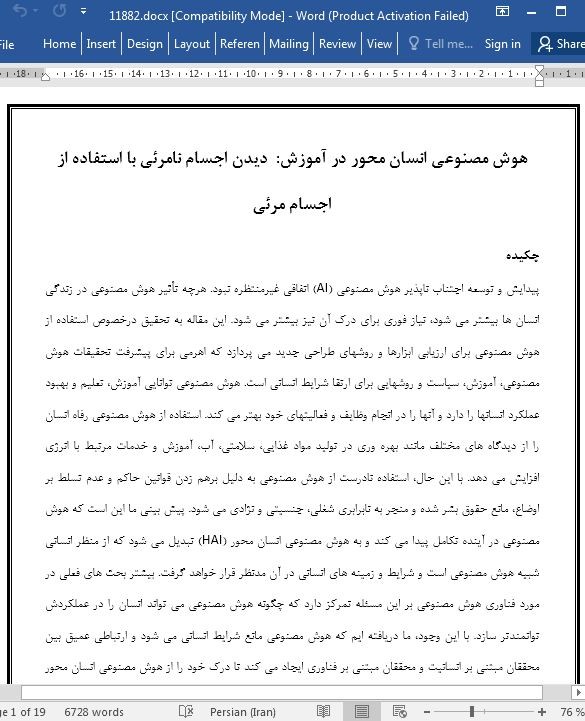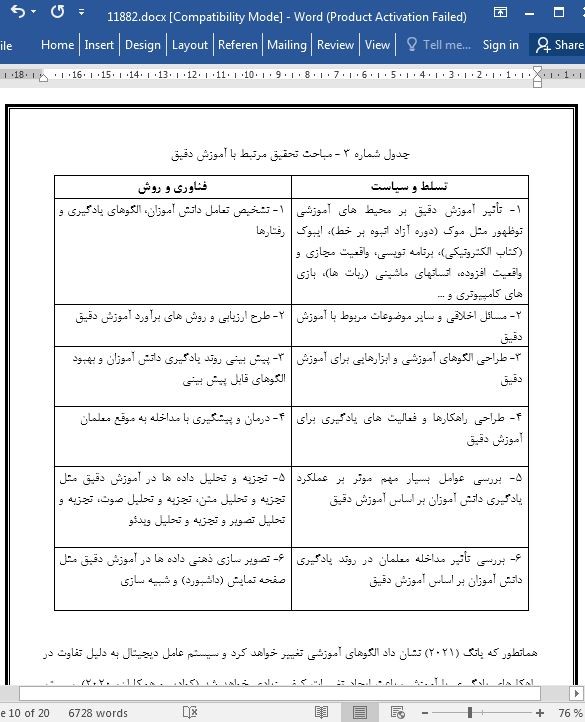
هوش مصنوعی انسان محور در آموزش: دیدن اجسام نامرئی با استفاده از اجسام مرئی
چکیده
پیدایش و توسعه اجتناب ناپذیر هوش مصنوعی (AI) اتفاقی غیرمنتظره نبود. هرچه تأثیر هوش مصنوعی در زندگی انسان ها بیشتر می شود، نیاز فوری برای درک آن نیز بیشتر می شود. این مقاله به تحقیق درخصوص استفاده از هوش مصنوعی برای ارزیابی ابزارها و روشهای طراحی جدید می پردازد که اهرمی برای پیشرفت تحقیقات هوش مصنوعی، آموزش، سیاست و روشهایی برای ارتقا شرایط انسانی است. هوش مصنوعی توانایی آموزش، تعلیم و بهبود عملکرد انسانها را دارد و آنها را در انجام وظایف و فعالیتهای خود بهتر می کند. استفاده از هوش مصنوعی رفاه انسان را از دیدگاه های مختلف مانند بهره وری در تولید مواد غذایی، سلامتی، آب، آموزش و خدمات مرتبط با انرژی افزایش می دهد. با این حال، استفاده نادرست از هوش مصنوعی به دلیل برهم زدن قوانین حاکم و عدم تسلط بر اوضاع، مانع حقوق بشر شده و منجر به نابرابری شغلی، جنسیتی و نژادی می شود. پیش بینی ما این است که هوش مصنوعی در آینده تکامل پیدا می کند و به هوش مصنوعی انسان محور (HAI) تبدیل می شود که از منظر انسانی شبیه هوش مصنوعی است و شرایط و زمینه های انسانی در آن مدنظر قرار خواهد گرفت. بیشتر بحث های فعلی در مورد فناوری هوش مصنوعی بر این مسئله تمرکز دارد که چگونه هوش مصنوعی می تواند انسان را در عملکردش توانمندتر سازد. با این وجود، ما دریافته ایم که هوش مصنوعی مانع شرایط انسانی می شود و ارتباطی عمیق بین محققان مبتنی بر انسانیت و محققان مبتنی بر فناوری ایجاد می کند تا درک خود را از هوش مصنوعی انسان محور از دیدگاه های مختلف توسعه دهیم.
1.مقدمه
روند تحقیق در مورد هوش مصنوعی از برنامه های فناوری گرا، که بر افزایش تولید و عملکرد متمرکز هستند، به برنامه های انسانی گرا که بر تقویت هوش انسان با استفاده از هوش ماشینی متمرکز هستند، تبدیل شده است (یانگ، 2021).تغییر روند در تحقیقات هوش مصنوعی مشکلات جدیدی به وجود آورده است، از جمله تغییر مسیر از اهداف عمومی به سمت انتقال هوش، از محاسبات به شناخت، از سفارشی سازی به سازگاری، از شناخته ها به ناشناخته ها، از یک قالب مناسب برای همه به قالبی دقیق و از فناوری به بشریت (یانگ، 2019).
Abstract
The inevitable rise and development of artificial intelligence (AI) was not a sudden occurrence. The greater the effect that AI has on humans, the more pressing the need is for us to understand it. This paper addresses research on the use of AI to evaluate new design methods and tools that can be leveraged to advance AI research, education, policy, and practice to improve the human condition. AI has the potential to educate, train, and improve the performance of humans, making them better at their tasks and activities. The use of AI can enhance human welfare in numerous respects, such as through improving the productivity of food, health, water, education, and energy services. However, the misuse of AI due to algorithm bias and a lack of governance could inhibit human rights and result in employment, gender, and racial inequality. We envision that AI can evolve into human-centered AI (HAI), which refers to approaching AI from a human perspective by considering human conditions and contexts. Most current discussions on AI technology focus on how AI can enable human performance. However, we explore AI can also inhibit the human condition and advocate for an in-depth dialog between technology- and humanity-based researchers to improve understanding of HAI from various perspectives.
1. Introduction
The research trend on artificial intelligence (AI) is shifting from technology-oriented applications, which focus on increasing production and performance, to humanity-oriented applications, which focus on augmenting human intelligence with machine intelligence (Yang, 2021). The shifting of AI research trend has brought about new challenges, including shifts from general-purpose to transfer intelligence, computation to cognition, customization to adaptation, known to unknown, one-size-fits-all to precision, and technology to humanity (Yang, 2019).
چکیده
1 مقدمه
1-1 روندها و مشکلات تحقیقات هوش مصنوعی
1-2 هوش مصنوعی انسان محور
2 حالات انسانی و فناوری برای هوش مصنوعی انسان محور
2-1 تأثیر اجتماعی هوش مصنوعی
2-2 در مسیر هوش مصنوعی پایدار
3 محیط های یادگیری هوشمند برای هوش مصنوعی انسان محور
1-3 آموزش دقیق
3-2 تجزیه و تحلیل یادگیری هوشمند
3-3 ارزیابی هوشمند
4 بحث: از فناوری بی جان تا انسان جاندار
5 نتیجه گیری
اظهارنامه منافع رقابتی
قدردانی
منابع
Abstract
1. Introduction
1.1. AI research trends and challenges
1.2. Human-centered AI
2. Humanity and technology for human-centered AI
2.1. Societal impact of AI
2.2. Toward sustainable AI
3. Smart learning environments for human-centered AI
3.1. Precision education
3.2. Smart learning analytics
3.3. Smart assessment
4. Discussion: From cold technology to warm humanity
5. Conclusion
Declaration of competing interest
Acknowledgments
References
- اصل مقاله انگلیسی با فرمت ورد (word) با قابلیت ویرایش
- ترجمه فارسی مقاله با فرمت ورد (word) با قابلیت ویرایش، بدون آرم سایت ای ترجمه
- ترجمه فارسی مقاله با فرمت pdf، بدون آرم سایت ای ترجمه



